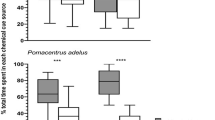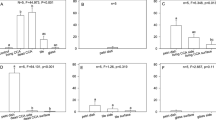Abstract
Planktonic larvae of the serpulid polychaete Spirobranchus giganteus, an obligate associate of live coral, were tested for preferences for materials diffusing from natural substrates. Choices offered were Acropora prolifera, a very abundant coral on the Heron Island reef flat; Palauastraea ramosa, a less abundant coral, dead coral rubble and a glass tube as a control. Larval life is approximately 12 days. The larvae tested were 1–4 days old. Adults of S. giganteus occur commonly on A. prolifera and much less frequently on P. ramosa. Experiments were designed to prevent contact between larvae and substrate. Larvae preferred A. prolifera over P. ramosa, rubble and the control. There was no preference expressed between the control and P. ramosa or the control and rubble. A preference by young S. giganteus larvae for a substance diffusing from coral, acting together with a known positive phototaxis, may be adaptive in that it may help to maintain larvae in surface waters over the reef and in the vicinity of a specific coral until they are old enough to settle.
Similar content being viewed by others
References
Al-Ogilvy SM (1985) Further experiments on larval behaviour of the tubiculous polychaete Spirorbis inornatus L. Hardy and Quiévreux. J Exp Mar Biol Ecol 86:285–298
Bhaud M (1969) Etude de la migration verticale quotidienne des larves de Mesochaetopterus sagittarius a Nosy-Bé (Madagascar) Mar Biol 4:28–35
Daro MH (1973) Etudes des migrations nycthemerales du zooplankton dans un milieu marin peu profond. Hydrobiologia 44:149–160
DeVantier LM, Riechelt RE, Bradbury RH (1986) Does Spirobranchus giganteus protect host Porites from predation by Acanthaster planci: predator pressure as a mechanism of coevolution? Mar Ecol Prog Ser 32:307–310
Doyle RW (1975) Settlement of planktonic larvae: a theory of habitat selection in varying environments. Am Nat 109:113–126
Eckelbarger KJ (1977) Metamorphosis and settlement in the Sabellariidae. In: Chia F-S, Rice ME (eds), Settlement and metamorphosis of marine invertebrate larvae. Elsevier, New York, pp 127–144
Hermans CO (1977) Metamorphosis in the ophelid polychaete Armandia brevis. In: Chia F-S, Rice ME (eds) Settlement and metamorphosis of marine invertebrate larvae. Elsevier, New York, pp 113–126
Hove HA ten (1970) Serpulinae (Polychaeta) from the Caribbean. 1. The genus Spirobranchus. Stud Fauna Curacao. 32:1–57
Jensen RA, Morse DE (1984) Intraspecific facilitation of larval recruitment: gregarious settlement of the polychaete Phragmatopoma californica (Fewkes) J Exp Mar Biol Ecol 83:107–126
Johannes RE (1978) Reproductive strategies of coastal marine fishes in the tropics. Environ Biol Fish 3:65–84
Konstantinova MI (1966) Characteristics of motion of pelagic larvae of marine invertebrates. Dokl Akad Nauk SSSR 170:726–729
Marsden JR (1984) Swimming in response to light by larvae of the tropical serpulid Spirobranchus giganteus. Mar Biol 83:13–16
Marsden JR (1986) Response to light by trochophore larvae of Spirobranchus giganteus. Effects of level of irradiance, dark adaptation and spectral distribution. Mar Biol 93:13–16
Mileikovsky SA (1973) Speed of active movement of pelagic larvae of marine bottom invertebrates and their ability to regulate their vertical position. Mar Biol 23:11–17
Potswald HE (1977) Metamorphosis in Spirorbis (Polychaeta). In: Chia F-S, Rice ME (eds) Settlement and metamorphosis of marine invertebrate larvae. Elsevier, New York, pp 127–144
Smith R (1985) Photoreceptors of serpulid polychaetes. PhD thesis, James Cook University of North Queensland, Townsville, Australia
Sokal RR, Rohler FJ (1981) Biometry 2nd edn. Freeman, New York
Williams GB (1964) The effects of extracts of Fucus serratus in promoting the settlement of larvae of Spirorbis borealis (Polychaeta). J Mar Biol Assoc UK 44:397–414
Wilson DD (1970) The larvae of Sabellaria spinulosa and their settlement behaviour. J Mar Biol Assoc UK 50:33–52
Author information
Authors and Affiliations
Rights and permissions
About this article
Cite this article
Marsden, J.R. Coral preference behaviour by planktotrophic larvae of Spirobranchus giganteus corniculatus (Serpulidae: Polychaeta). Coral Reefs 6, 71–74 (1987). https://doi.org/10.1007/BF00301376
Accepted:
Issue Date:
DOI: https://doi.org/10.1007/BF00301376




